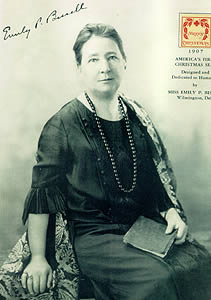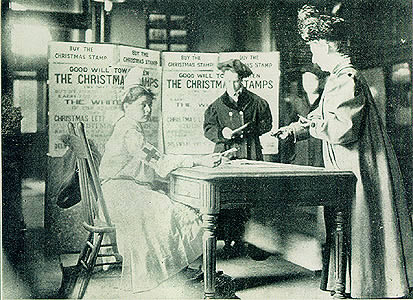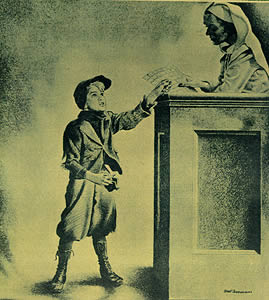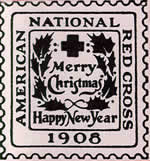Stamping out Tuberculosis with Christmas Seals
Emily Bissell of the American Red Cross Begins Selling Christmas Seals

Emily Bissell and the first Christmas Seal, 1907
The fledgling National Association for the Study and Prevention of Tuberculosis (NASPT) could not financially support every sanatorium in the country. Many, like the tiny Brandywine Sanatorium near Wilmington, Delaware, were barely able to stay open. In 1907, Dr. Joseph Wales, a physician at Brandywine, asked his cousin, Ms. Emily Bissell, for help. Ms. Bissell was an active member of the American Red Cross with considerable experience in fund-raising. Her mission was to raise the $300 necessary to keep Brandywine Sanatorium in operation through the winter.
Bissell got the idea for a sale of Christmas Seals from an article written by a Danish-American journalist and social worker named Jacob Riis. In his article, Riis referred to a successful sale of Christmas seals in 1904 in Denmark that raised $20,000 in the fight against tuberculosis. Bissell agreed with Riis’s suggestion that America do the same. She borrowed money from friends to print the first 50,000 Seals, got permission from the Wilmington postmaster to sell them in the post office lobby, and sold the first Christmas Seal on December 7, 1907.

Emily Bissell buying the first Seal at the Wilmington post office, 7 December 1907
The Seals were placed in envelopes on which the following message was printed:
Put this stamp with message bright
On every Christmas letter;
Help the tuberculosis fight,
And make the New Year better.
These stamps do not carry any kind of mail
but any kind of mail will carry them.

“Gimme one — me sister’s got it.”
On her first day, Bissell raised $25. But when sales tapered off during the next several days, she realized that she was no longer on pace to reach her goal of $300. Desperate, she jumped on the train to Philadelphia, where she hoped to find a voice for her cause in The North American, one of the city’s most popular newspapers. She succeeded. Every day articles appeared in the paper under the heading, “Stamp Out Tuberculosis.” One story was about the “ragged little newsboy” who bought a Christmas Seal early in the Philadelphia campaign. According to Leigh Mitchell Hodges, senior staff writer for The North American, the newsboy’s purchase of a Seal proved that people believed in the Christmas Seal Campaign and its goal to eradicate TB. With the articles in the newspaper, Bissell’s Seals sold so quickly that she had to order another 250,000. The Philadelphia campaign caught the attention of President Theodore Roosevelt, who enthusiastically endorsed the Seals. By the end of the Christmas season, Emily Bissell had raised $3,000.[1]
Christmas Seals and the American Red Cross

Amy Hughes, age 6, with Seals, 1967
Bissell’s Christmas Seal Campaign went national the following year with the official sponsorship of the American Red Cross. In its second year, the sale of Christmas Seals raised $135,000 against tuberculosis. In 1909, the campaign produced $250,000. The American Red Cross sponsored the Christmas Seal until 1919, when the National Tuberculosis Association (the new name for the NASPT) was finally strong enough to assume exclusive control of the project. The emblem of the NTA, the double-barred cross, appeared for the first time on a Christmas Seal in 1920.


The double-barred cross is a modification of the Cross of Lorraine, which is itself a variation of the Jerusalem, or Patriarchal, Cross. Godfrey, Duke of Lorraine and a leader of the First Crusade, commandeered the cross in 1099 when he was made ruler of Jerusalem. In 1902, Dr. Gilbert Sersiron of Paris proposed that the Lorraine Cross be made the emblem of the anti-TB “crusade” at the International Conference on Tuberculosis held in Berlin. The NASPT adopted the cross in 1906 and registered their new emblem as an official trademark in 1920.[2]

Lee Trevino, Christmas Seal Chair, 1971
Since 1959, celebrities have chaired the Christmas Seal Campaign, including Jacqueline Kennedy Onassis, Bob Hope, Lee Trevino, Johnny Bench, Pearl Bailey, and Cybill Shepherd. Early Christmas Seals have attracted the attention of stamp collectors, some of whom pay several hundred dollars for a single Seal. In 1980, Ms. Emily Bissell, “Crusader Against Tuberculosis,” and the double-barred cross of the ALA appeared on a postage stamp. Now one of the best known fund-raisers in the country, the Christmas Seal Campaign raises millions of dollars to prevent, cure, and control lung disease.[3]
Sources
[1] The Story of Christmas Seals (American Lung Association, 1987), 2-5.
[2] S. Adolphus Knopf, A History of the National Tuberculosis Association: The Anti-Tuberculosis Movement in the United States (New York: NTA, 1922), 152-54.
[3] The Story of Christmas Seals, 5-13.